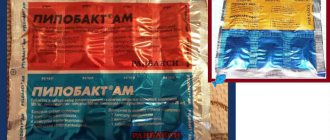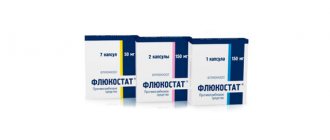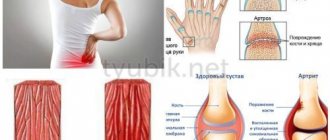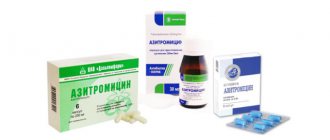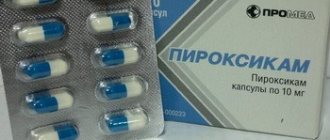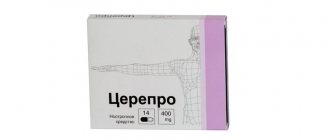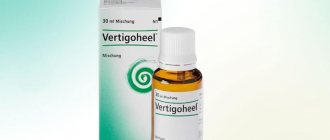Category: Published 10/28/2019 · Comments: · Reading time: 5 min · Views: 2,317
Vinpotropil is a combined nootropic and cerebrovasodilating drug. The instructions for use explain that tablets 10 mg + 800 mg, injections in injection ampoules 1 mg + 80 mg, capsules 5 mg + 400 mg help with stroke. Why Vinpotropil is prescribed, prices, reviews from patients and doctors, as well as analogues of the drug will be discussed in the article.
Vinpotropil capsules
Release form and composition
Dosage forms of Vinpotropil:
- Film-coated tablets: oval, light brown with a grayish tint, scored, almost white in cross section (10 pcs. in strip packs, 3 or 6 packs in a cardboard pack);
- Capsules: size No. 0, yellow with a red cap; contents – white powder, there may be individual lumps and crystals (10 pcs. in blister packs, in a cardboard pack of 2, 3, 5 or 10 packs; 15 pcs in blister packs, in a cardboard pack of 2, 4 or 6 packs; 15 or 50 pieces each in polyethylene bottles, 1 bottle in a cardboard box);
- Concentrate for the preparation of a solution for infusion: transparent, colorless or slightly colored (5 ml in dark glass ampoules: 5 ampoules in a cardboard box; 5 ampoules in a blister pack, in a cardboard box 2 packs; 10 ampoules in a blister pack, in a cardboard box pack 1 or 2 packs).
Active ingredients in 1 tablet:
- Vinpocetine – 10 mg;
- Piracetam – 800 mg.
Active ingredients in 1 capsule:
- Vinpocetine – 5 mg;
- Piracetam – 400 mg.
Active ingredients in 1 ml of concentrate:
- Vinpocetine – 1 mg;
- Piracetam – 80 mg.
Excipients of tablets: croscarmellose sodium, calcium hydrogen phosphate dihydrate, povidone, magnesium stearate, microcrystalline cellulose, talc.
Composition of the tablet shell: opadry II brown (lactose monohydrate, macrogol, hypromellose, titanium dioxide, dyes iron oxide red and iron oxide black).
Excipients of capsules: calcium stearate and lactose.
Excipients of the concentrate: sodium disulfite (sodium metabisulfite), succinic acid, ascorbic acid, water for injection.
Pharmacodynamics and pharmacokinetics
Vinpotropil is a combination drug that can improve cerebral blood flow thanks to the active substance - vinpocetine and provide a nootropic effect through the active substance included in the composition - piracetam .
Vinpocetine is able to improve brain metabolism by increasing the consumption of glucose and oxygen , the metabolism of norepinephrine and serotonin , the resistance of neurons to hypoxia , and has an antioxidant effect . Increased transport of glucose occurs through the BBB , while the processes of breakdown of glucose molecules become more energy-efficient: through the aerobic pathway, Ca2+-dependent PDE is selectively blocked and the level of AMP , catecholamines , as well as cyclic GMP and ATP of the brain increases. Regarding the blood system, it reduces the viscosity and aggregation of platelets , increases the plasticity of oxygen carriers - erythrocytes , blocks their utilization of adenosine and activates the release of oxygen. Increased cerebral blood flow does not cause significant changes in systemic circulation. It has been established that the substance can penetrate the placental and histohematic barriers .
Piracetam is included as an active ingredient in Vinpotropil to optimize the integrative activity of the brain: by promoting the consolidation of memory and the speed of spread of excitation, the connection of the hemispheres, makes the learning process more effective. In addition, no sedative or psychostimulating effect is observed. Under the influence of drugs, microcirculation and aggregation of activated platelets , which has a cerebroprotective effect during hypoxia , intoxication , and exposure to electric shock. The EEG shows that α- and β-activities increase, δ-activity decreases, and the severity of vestibular nystagmus is reduced. At the initial stage of cerebrovascular disorders in elderly and senile age, it has a pronounced effect. Penetrating through the GE and placental barriers , it is effectively removed by hemodialysis .
Pharmacokinetics of the concentrate (parenteral administration)
- Vinpocetine reaches a therapeutic concentration in plasma of 10–20 ng/ml, with a volume of distribution of 5.3 liters per kg, binds to proteins by 66 percent with a clearance of 66.7 l/h, and has extrahepatic metabolism. 0.25% is present in breast milk within an hour, half-life is 220–367 minutes. Elimination by the kidneys and intestines (ratio 3:2).
- The half-life of piracetam from plasma is 4.5 hours, from the brain - 7.7 hours, from cerebrospinal fluid - 8.5 hours (in case of chronic and terminal renal failure, it can be extended to 2.5 days). Practically without undergoing biotransformation, two-thirds of the substance is excreted by the kidneys in 30 hours, with a total clearance of 80–90 ml. Studies in vivariums have shown that the substance selectively accumulates in the tissues of the GM cortex, mostly in the basal ganglia, in the frontal lobes, parietal lobes, occipital lobes and in the cerebellum.
Pharmacokinetics of tablets and capsules
The maximum concentration of vinpocetine is reached after 2–4 hours, and the absorption process occurs mainly in the initial parts of the gastrointestinal tract. Subsequent oral administrations produce linear kinetics. Half-life approximately 290 minutes. While the bioavailability of piracetam is approximately 100%, the maximum concentration is 84 mcg per ml after an hour, repeated doses increase it to 115 mcg per ml.
Pharmacological properties
Pharmacodynamics
Vinpotropil is a combination drug, the effect of which is determined by the properties of its active components: cerebrovasodilating (vinpocetine) and nootropic (piracetam).
Vinpocetine improves cerebral circulation, dilates blood vessels in the brain, increases blood flow, and improves the supply of glucose and oxygen to the brain. Facilitates the transport of oxygen and energy supply substrates to tissues, thereby increasing the resistance of brain cells to hypoxia. Increases the content of catecholamines in brain tissue, and promotes the accumulation of cyclic adenosine monophosphate and adenosine triphosphate.
The vasodilating effect of vinpocetine is associated with its direct relaxing effect on vascular smooth muscle, especially the brain. Vinpotropil increases blood supply to the ischemic area of the brain, while not causing the steal phenomenon and does not change the blood supply to intact areas of the brain. Increases the elasticity of red blood cells, reduces platelet aggregation and reduces blood viscosity, thereby improving microcirculation in the brain.
Piracetam is a cyclic derivative of gamma-aminobutyric acid and has a nootropic effect. This substance has a direct effect on the brain, thereby improving performance and cognitive processes such as attention, memory and learning ability. It influences the central nervous system in various ways: it affects the rheological characteristics of the blood, improves microcirculation, changes the speed of spread of excitation in the brain, improves metabolic processes in nerve cells. At the same time, it does not have a vasodilating effect.
Vinpotropil improves cerebral blood flow, communication between the cerebral hemispheres and synaptic conduction in neocortical structures.
The drug suppresses platelet aggregation, restores the configuration properties of the outer membrane of rigid erythrocytes, normalizes the ability of rigid erythrocytes to pass through the vessels of the microvasculature.
At a dose of 9.6 g, Vinpotropil prolongs bleeding time and reduces the concentration of fibrinogen and von Willebrand factor by 30-40%. It has a restorative and protective effect in cases of impaired brain function due to intoxication and hypoxia. Reduces the duration and severity of vestibular nystagmus.
Pharmacokinetics
Pharmacokinetic characteristics of the active components of Vinpotropil:
- Vinpocetine: after taking the drug orally, it is quickly absorbed in the gastrointestinal tract, mainly in its proximal parts. It is not metabolized when passing through the intestinal wall. Maximum plasma concentration is achieved within 1 hour. Therapeutic plasma concentrations of vinpocetine after oral and parenteral administration are 10–20 ng/ml. Bioavailability of the drug is 50–70%, binding to proteins is 66%. Clearance is 66.7 l/h, this figure exceeds the plasma volume of the liver (50 l/h), which indicates extrahepatic metabolism of the drug. The main metabolite of vinpocetine, apovincamic acid, has little pharmacological activity. Other inactive metabolites are hydroxyvinocamic acid, hydroxyvinpocetine, and hydroxyvinpocetine glycinate. Pharmacokinetics with repeated use is linear. Excreted by the kidneys and through the intestines in a ratio of 3:2. It is eliminated from the cerebrospinal fluid much more slowly than from other tissues. The half-life is an average of 4.8 hours (3.54–6.12). Easily penetrates histohematic barriers (including the blood-brain barrier), the placental barrier and into breast milk;
- piracetam: penetrates well into various tissues and organs. In animal experiments, it was found that the substance selectively accumulates in the tissues of the cerebral cortex, mainly in the occipital, parietal and frontal lobes, basal ganglia and cerebellum. It is characterized by very high bioavailability - about 100%. After a single oral dose of 3.2 g, the maximum concentration is 84 mcg/ml, after repeated use (3.2 g three times a day) - 115 mcg/ml. The maximum concentration in plasma is achieved within 1 hour, in the cerebrospinal fluid - within 5 hours. The volume of distribution is about 0.6 l/kg. Total clearance 80–90 ml/min. Penetrates through the blood-brain and placental barriers. Does not bind to plasma proteins. Practically not metabolized. It is excreted unchanged by the kidneys by glomerular filtration within 30 hours. The half-life from blood plasma is 4–5 hours, from the brain – 7.7 hours, from cerebrospinal fluid – 8.5 hours. In chronic renal failure, the half-life is extended (up to 59 hours in the terminal stage). Piracetam is removed by hemodialysis.
Pharmacological effects
Vinpocetine improves cerebral blood flow, piracetam has a nootropic effect - improves cerebral blood flow and blood microcirculation. Brain metabolism is enhanced by the consumption of glucose and the supply of oxygen.
The drug has an antioxidant effect, enhances the metabolism of norepinephrine and serotonin, and increases the resistance of neurons to hypoxia - a decrease in oxygen content. In the blood, the medicine reduces viscosity and platelet aggregation, increases the plasticity of red blood cells, and blocks the utilization (absorption) of adenosine, which improves oxygen delivery.
Indications for use
For all dosage forms of Vinpotropil:
- Parkinsonism of vascular origin;
- Cerebrovascular insufficiency (recovery period after hemorrhagic and ischemic stroke);
- Psychoorganic syndrome with a predominance of signs of adynamia and asthenia;
- Intoxication.
Additionally for tablets:
- Symptomatic treatment of vertigo;
- Chronic cerebral circulatory failure of post-traumatic and hypertensive origin;
- Prevention of kinetosis and migraine.
Additionally for capsules and concentrate for the preparation of infusions:
- Labyrinthopathies;
- Asthenic syndrome;
- Brain injuries and other diseases of the central nervous system, accompanied by a decrease in intellectual and mental functions;
- Meniere's syndrome;
- Encephalopathies of various origins, including alcoholism.
In addition, Vinpotropil capsules are prescribed for the prevention of kinetosis and migraine.
Overdose
An overdose of vinpocetine is accompanied by an increase in the severity of dose-dependent adverse reactions. For treatment, gastric lavage , activated charcoal and symptomatic therapy are prescribed.
An overdose of piracetam causes abdominal pain and bloody diarrhea . They are treated symptomatically, hemodialysis in this case is 50–60% effective. specific antidote has been found.
Contraindications
Absolute:
- Acute stage of hemorrhagic stroke;
- Coronary heart disease (severe);
- Severe heart rhythm disturbances;
- Lactase deficiency, glucose-galactose malabsorption, lactose intolerance (for tablets);
- Kidney/liver failure;
- Age up to 18 years;
- Pregnancy;
- Lactation;
- Hypersensitivity to the components of Vinpotropil.
Relative (due to the risk of complications, special care should be taken):
- Heavy bleeding;
- Impaired hemostasis;
- Viral hepatitis;
- Epilepsy;
- Alcoholic liver damage;
- Benign hyperbilirubinemia (including Gilbert's syndrome);
- Alcoholism;
- Elderly age;
- Glucose-6-phosphate dehydrogenase deficiency (for tablets and capsules).
Instructions for use of Vinpotropil: method and dosage
Film-coated tablets
In tablet form, Vinpotropil is taken orally with a sufficient amount of water, regardless of food intake, 1 piece. 2-3 times a day (the last dose should be approximately 4 hours before bedtime). Depending on the clinical picture, treatment can last from 2 weeks to 6 months, which is determined strictly by the doctor. Before discontinuing the drug, it is recommended to gradually reduce the dose.
Capsules
In capsule form, Vinpotropil is taken orally, 1-2 pieces. 2-3 times a day (the last dose should be approximately 4 hours before bedtime). During maintenance therapy, capsules are prescribed 1 piece. 3 times a day. Depending on the clinical picture, treatment can last from 2 weeks to 6 months. Before discontinuing the drug, it is recommended to gradually reduce the dose.
Concentrate for the preparation of solution for infusion
Vinpotropil concentrate is administered intravenously at a rate of up to 80 drops per minute once a day. A single dose is 2-3 ampoules, pre-diluted with 500 ml of 0.9% sodium chloride solution or another solution containing dextrose. The duration of therapy is 10-14 days. If necessary, the course is repeated after 6-8 weeks.
After the patient’s condition improves, they are transferred to the oral form of Vinpotropil.
Analogues of Vinpotropil
Analogs are prescribed for treatment:
- Noofen;
- Stamin;
- Noben;
- Metostabil;
- Phezam;
- Choline alfoscerate;
- Kudesan;
- Gliatilin;
- Holitylin;
- Mexidol;
- Cebrilisin;
- Glycine;
- Combitropil;
- Tenoten for children;
- Omaron;
- Cerepro;
- Semax;
- Cavinton;
- Lutsetam;
- Mexiprim;
- Amylonosar;
- Noopept;
- Recognan;
- Ceraxon;
- Mexicofin;
- Noocetam;
- Bilobil;
- Nootropil;
- Meclofenoxate hydrochloride;
- Piracetam;
- Encephabol;
- Divaza;
- Hopantenic acid;
- Minisem;
- Glutamic acid;
- Intellan;
- Idebenone;
- Glycine forte;
- Pirabene;
- Citicoline sodium;
- Picamilon;
- Pyracesin;
- NooKam;
- Cereton;
- Gammalon;
- Neuromet;
- Memotropil;
- Gopantam;
- Pantogam;
- Cerebrolysin;
- Cortexin;
- Thiocetam;
- Ethylthiobenzimidazole hydrobromide;
- Tenoten;
- Gamma-aminobutyric acid;
- Pantocalcin;
- Quinelle;
- Cerebrolysate;
- Escotropile;
- Phenotropil;
- Phenibut.
Side effects
- Cardiovascular system: changes in the electrocardiogram (prolongation of the QT interval, depression of the ST segment), lability of blood pressure, extrasystole, sensation of hot flashes, tachycardia, worsening of angina pectoris;
- Central nervous system: dizziness, irritability, headache, decreased ability to concentrate, sleep disturbances, imbalance, motor disinhibition, anxiety, ataxia, mental agitation, tremor, convulsions, extrapyramidal disorders (including hyperkinesis), depression;
- Digestive system: dry mouth, diarrhea, heartburn, nausea, gastralgia, vomiting;
- Skin: dermatitis, urticaria, redness, itching;
- Sense organs: vertigo;
- Others: weight gain, general weakness, asthenia, increased sweating, increased sexual activity, allergic reactions.
In addition, when using the concentrate to prepare a solution for Vinpotropil infusion, local reactions are possible: pain at the injection site and thrombophlebitis.
Side effects
Numerous studies show that in most cases the drug is well tolerated and no adverse reactions occur.
The drug may cause side effects such as:
- Increased sexual excitability;
- Slowing of AV conduction;
- Decreased appetite;
- Tachycardia;
- Mental excitement;
- Nausea;
- Constipation;
- Anxiety;
- Headache;
- Extrapyramidal disorders;
- Vomiting;
- Diarrhea;
- Sleep disorders;
- Extrasystoles;
- Irritability;
- Decreased concentration;
- Headaches and dizziness.
By
special instructions
Patients diagnosed with a prolonged QT interval should have an electrocardiogram periodically monitored during treatment.
Piracetam, one of the active ingredients of Vinpotropil, affects platelet aggregation, and therefore it is recommended to be careful when prescribing the drug to patients with impaired hemostasis, with symptoms of severe bleeding, as well as during major surgical operations.
Patients with lactose intolerance should take into account that 1 capsule contains about 225 mg of lactose.
Impact on the ability to drive vehicles and complex mechanisms
During treatment, care must be taken when driving vehicles and performing potentially hazardous activities.
Drug interactions
- Heparin: the risk of hemorrhagic complications increases;
- Psychostimulants, antipsychotics, thyroid hormones: their effects are enhanced;
- Indirect anticoagulants, including acenocoumarol: their effect is enhanced, there is a more pronounced decrease in platelet aggregation, fibrinogen content, von Willebrand factor, blood and plasma viscosity;
- Methyldopa: its hypotensive effect is enhanced (it is necessary to control blood pressure);
- Anticonvulsants: their effect is weakened, the seizure threshold decreases.
There is no data confirming the possibility of interaction of Vinpotropil with drugs of central and antiarrhythmic action, however, caution should be exercised when prescribing such a combination.
The concentrate for the preparation of solution for infusion is compatible with 5, 10 and 20% dextrose solutions, 5, 10 and 20% fructose solutions, Ringer's solution, 0.9% sodium chloride solution, 6 and 10% hydroxyethyl starch, 20% mannitol solution.
Reviews about Vinpotropil
Doctors speak positively about Vinpotropil. This drug is used in psychogeriatric practice (for the treatment of senile dementia), for cerebrovascular insufficiency, brain injury, intoxication and other conditions accompanied by a decrease in intellectual and mnestic functions, as well as for the prevention of migraine and motion sickness.
Reviews of Vinpotropil from patients who took it are also mostly positive. The drug significantly improves attention, memory and general well-being.
Vinpotropil price, where to buy
The price of Vinpotropil differs depending on the form of release:
- packaging containing 30 capsules - 160 rubles, 60 capsules - 320 rubles, 50 capsules in a bottle - 410 rubles;
- 10 ampoules of concentrate for infusion – 245 rubles;
- pack of tablets No. 10 – 270 rubles.
- Online pharmacies in RussiaRussia
- Online pharmacies in KazakhstanKazakhstan
ZdravCity
- Vinpotropil tablets p.p.o.
60 pcs. CJSC Kanonpharma Production 474 rub. order - Vinpotropil caps. 5mg+400mg 30 pcs. CJSC Kanonpharma Production
167 RUR order
- Vinpotropil tablets p.p.o. 10mg+800mg 30 pcs. Canonpharma Production CJSC
RUB 322 order
Pharmacy Dialogue
- Vinpotropil (caps. 5mg+400mg No. 60)Canonpharma Production
220 rub. order
- Vinpotropil (tablet p/o capt. 10 mg + 800 mg No. 60)Canonpharma Production
RUB 419 order
- Vinpotropil (caps. 5mg+400mg No. 30)Canonpharma Production
RUB 198 order
show more
